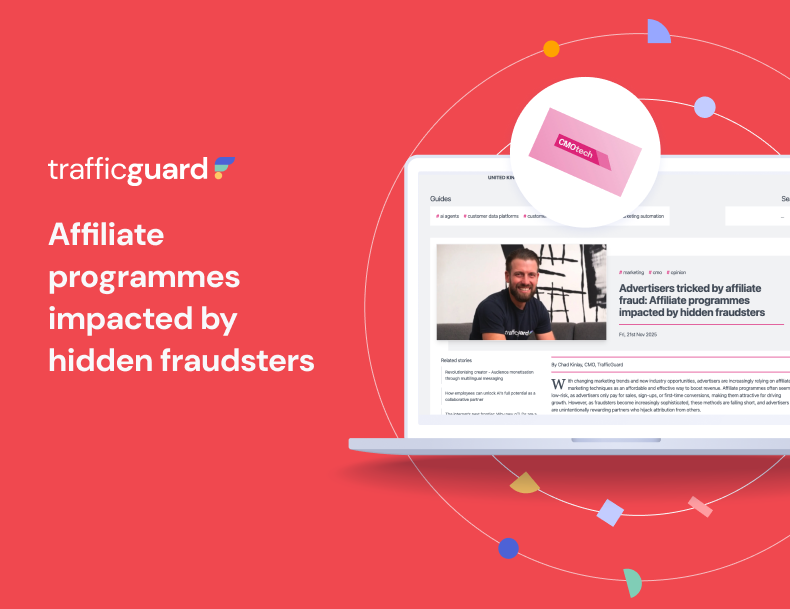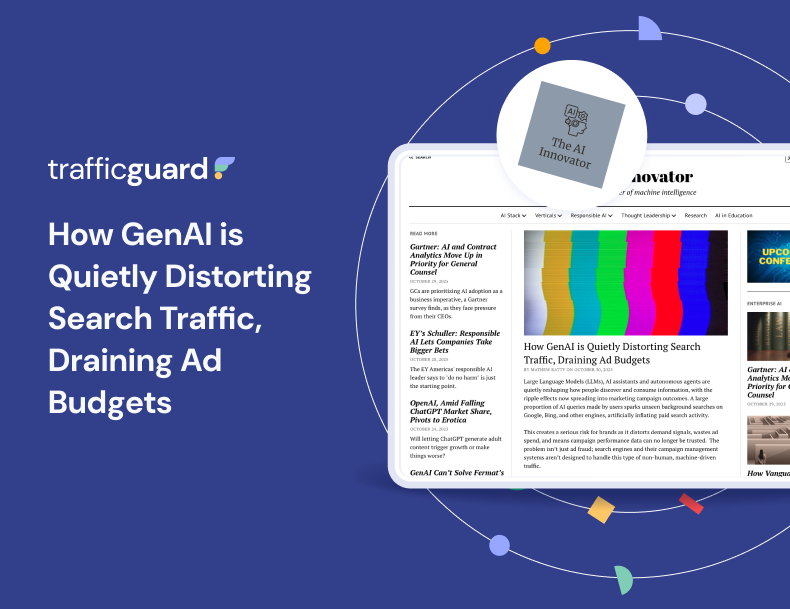Reactive ad fraud solutions are putting your ad spend at risk

This article was written by TrafficGuard Founder and COO, Luke Taylor for CPO Magazine.
The average ad spend per internet user in North America is 455% above the global average — and more ad spend means more opportunities for advertising fraud. Within the next five years, advertisers are expected to lose $100 million a day due to digital ad fraud, an increase of 125% since 2018.
Unfortunately, no digital advertising channel is immune to the effects of ad fraud, which are incredibly damaging for businesses. In the absence of anti-fraud solutions, the total global loss to digital advertising fraud could exceed $32 billion by 2023.
With so much on the line, advertisers must now consider fraud solutions that do more than just react to incidents. The future of the industry hinges on a proactive, preventative ad fraud solution.
Three tell-tale signs your business is a victim of digital ad fraud
The effects of digital ad fraud can seriously impact your bottom line: Fraudulent clicks and conversions muddy data used in decision making, which leads to misinformed and misaligned spending decisions. Fraud also causes advertisers to lose significant portions of media and ad spend that’s been diverted from legitimate traffic sources.
The unfortunate truth is that any company that advertises online is exposed to digital ad fraud in some capacity. Here are some key indicators:
- Extreme conversion rates: Low conversion rates paired with a high volume of clicks and impressions can be a sign of click spamming or flooding — click spamming occurs when bad actors attempt to claim attribution of an organic conversion by making it appear as though they delivered the last click before the conversion. However, the opposite scenario is equally concerning. Abnormally high conversion rates can be a sign that users are incentivized to engage with advertising, which if undisclosed, is considered non-compliant traffic.
- High volume of obscured traffic: IP addresses and device IDs can be easily obfuscated by fraudsters trying to disguise their Invalid traffic. Signs of this would be high volumes of traffic from VPNs, lots of traffic from new devices, LAT-enabled, JS-enabled or ad blocker-enabled devices. While some traffic like this is normal, high volumes can be a sign of malicious activity.
- Irregular user behaviour: If a user executes multiple clicks at the same time and from different locations or extremely short click-to-conversion times, you could be experiencing fraud. A significant drop-off at specific post-conversion events or bursts of traffic in between periods of inactivity can also indicate fraudulent activity.
Not all obscured, invalid or low-converting traffic is fraudulent. However, you can only monitor and benchmark performance after implementing a verification solution that can identify fraud, and more broadly, invalid traffic, in line with standards — which makes a proactive approach critical.
Learn more: How to spot a Fraud Prevention Specialist
How to protect your business from digital ad fraud with a preventative approach
Traditional ad fraud solutions waste time and effort attempting to identify the fraudster. A more feasible approach is to shift towards proactive ad fraud prevention. This approach saves ad spend and has the potential to benefit the entire industry in the long run.
Rather than trying to find the ad fraud perpetrators, proactive ad fraud prevention simply stops invalid traffic as early as it can be reliably detected before it has the chance to take ad spend. This not only saves money but also protects the data advertisers and their traffic sources use for optimization. Not all ad fraud prevention solutions are created equal, so look for one that has the following characteristics:
- Multi-stage data analysis: Most solutions analyze invalid traffic (IVT) at just one stage of the advertising journey, such as the impression, click or attribution stage. Effective solutions analyze multiple stages at once, corroborating signals between the stages and ensuring that when fraudulent traffic evades one line of defence, it’s caught at the next stage.
- Real-time blocking capabilities: Real-time blocking capabilities that are pre-bid, pre-click or pre-attribution are essential to minimizing loss as well as bolstering advertising performance. By stopping ad fraud in real-time, data stays clean and optimization is faster and more effective, which drives advertising performance. However, that doesn’t mean the solution should take a blanket approach to blocking. Solutions with aggressive blocking policies can do more harm than good for advertising performance, resulting in high false-positive rates, false confidence in low-quality sources, and unfairly penalized sources of good quality traffic.
- Accessible reporting: Make sure your solution makes reporting accessible to all parties (sharing with ad agencies and traffic sources) and from all angles. The benefit is that all parties have access to accurate reporting when they need it to drive optimization, not just at billing time, which is typically the case.
- Machine learning and AI capabilities: Look for a solution that’s built for the long haul — solutions that feature machine learning and AI capabilities can process large and complex data sets, and learn and improve over time. Solutions limited by stagnant rules and capabilities struggle to perform when they encounter unfamiliar scenarios.
The elimination of fraud from the digital ad ecosystem happens one business at a time. As more businesses adopt proactive fraud prevention, the flow of funds to fraud perpetrators will slow — cutting off fraudsters at the source and making it harder for fraud to occur in the first place. So, by protecting your ad spend, you’re not only improving the integrity of your performance data but doing your part to strengthen the digital ad ecosystem as a whole.
Get started - it's free
You can set up a TrafficGuard account in minutes, so we’ll be protecting your campaigns before you can say ‘sky-high ROI’.
At TrafficGuard, we’re committed to providing full visibility, real-time protection, and control over every click before it costs you. Our team of experts leads the way in ad fraud prevention, offering in-depth insights and innovative solutions to ensure your advertising spend delivers genuine value. We’re dedicated to helping you optimise ad performance, safeguard your ROI, and navigate the complexities of the digital advertising landscape.
Subscribe
Subscribe now to get all the latest news and insights on digital advertising, machine learning and ad fraud.







